#korerima
Explore tagged Tumblr posts
Text

Fossolia - Ethiopian Green Bean & Carrot Stir Fry (Vegan)
#vegan#appetizer#lunch#ethiopian cuisine#east african cuisine#african cuisine#stir fry#green beans#carrots#tomatoes#onion#garlic#korerima#ginger#olive oil#sea salt
40 notes
·
View notes
Text
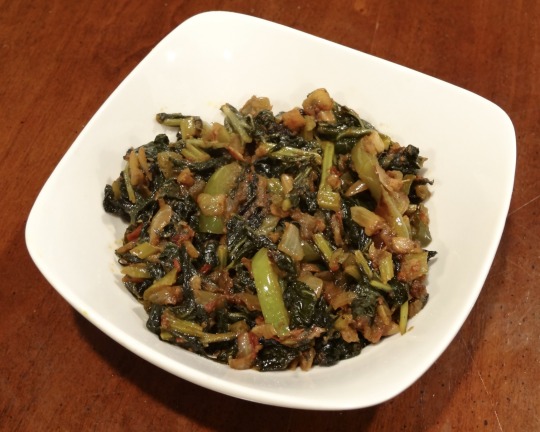
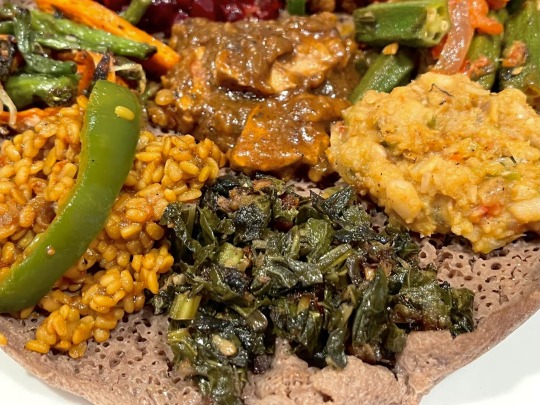
[ID: First image is bowl of collard greens with tomato and sliced jalepeño; second image shows several Ethiopian vegetable dishes on a piece of injera. End ID]
ጎመን / Gomen (Ethiopian collard greens)
This wot, or stew, consists of leafy greens that are cooked until tender with onion, garlic, ginger, tomato, and spices including korerima (Ethiopian false cardamom) and tikur azmud (nigella seeds). The result is a robust, flavorful side dish with an intensely aromatic finish.
Recipe under the cut!
Patreon | Tip jar
Ingredients:
12oz (340g) collard greens, kale, or other bitter greens, washed
1/4 cup avocado or sunflower oil, or other neutral oil
1 red onion, chopped or grated
2 cloves garlic, chopped
1 1/2 tsp minced ginger
1 tomato, minced
1 tsp cumin seeds, toasted and ground
1 tsp coriander seeds, toasted and ground
1/2 tsp Ethiopian false cardamom (korerima / ኮረሪማ; Aframomum melegueta), toasted and ground
1 tsp nigella seeds (tikur azmud / ጥቁር አዝሙድ; Nigella sativa), toasted and ground
1 jalapeño, sliced
Salt to taste (about 3/4 tsp table salt)
Mitmita (ሚጥሚጣ), to taste (see notes at end)
For more information on Ethiopian herbs and spices, including suggested substitutions, see the notes at the end of my berbere recipe.
Some recipes include niter kibbeh (ንጥር ቅቤ) in Ethiopian vegetable dishes such as gomen; this isn't typical, but you may add a teaspoon or so at the end of the cooking time if you have some lying around!
Instructions:
1. If using collard greens, discard any yellow leaves. Bend the end of each stem backwards and peel away the string that emerges. If the stems are stiff, remove them; if they are tender, they may be minced and included in the dish. Dice greens (finer than I did in the picture!).
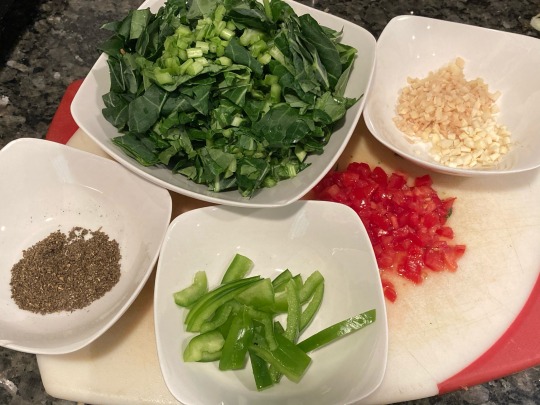
2. Heat onion, tomato, about a third of the garlic, and a pinch of salt in a dry pot on medium heat. Continue to cook, stirring and scraping the bottom of the pot often, until tomato is softened and onion is translucent.
Beginning the cooking process without oil is traditional in Ethiopia, but if you’re worried that they may stick, you may heat a little oil in the pot before adding the onion, tomato, and garlic.
3. Add oil and sauté, stirring occasionally, for about 10 minutes, until mixture is very soft and homogenous. Lower heat it ncessary.
4. Add ginger and another third of the garlic and sauté for about 30 seconds, until no longer raw-smelling.
5. Add ground spices and a couple tablespoons of water. Heat until simmering and add chopped greens.
6. Cover and cook, stirring occasionally, until tender (about 20-30 minutes).
7. Add salt to taste, jalepeño, and the remainder of the garlic and cook for another couple minutes.
Serve warm as a side with injera, misir wat, doro wat, etc.
For the mitmita:
Mitmita is a spicy seasoning mix that may be included in Ethiopian dishes, or served at the table as a condiment. Preparations differ, but recipes usually include chili, korerima, and cloves, and may also include cumin, green cardamom, allspice, black pepper, cinnamon, or garlic powder.
Ingredients:
20 dried bird's-eye chili peppers (piri piri)
2 Tbsp cumin seeds (optional)
1 Tbsp korerima seeds
1 Tbsp green cardamom pods (optional)
2 tsp whole cloves
1-inch piece Ceylon cinnamon (optional)
Bags of bird's-eye chili peppers can be purchased at a halal grocery store, where they will likely be a product of India or Thailand; they may not be labelled "bird's-eye," but look for the small size and curved shape.
Instructions:
Toast spices one at a time in a small dry skillet on medium heat until fragrant. Allow to cool completely and then grind in a spice mill or using a mortar and pestle. Store in an airtight jar in a cool, dry place.
#Ethiopian#vegan recipe#vegan cooking#vegan recipes#ethiopian food#collard greens#kale#cooking#gluten free
135 notes
·
View notes
Text
also, in English-language recipes:
If an Arabic speaker says to add "lemon salt" to an African / Asian recipe, they almost certainly mean citric acid and not lemon salt (the Arabic for "citric acid" is "mlH limoun," "lemon salt").
If an Indian recipe calls for "bay leaf," they mean tej patta aka Indian bay leaf, not Mediterranean / laurel / Turkish bay leaves.
If an Indian recipe calls for "allspice," they probably mean kabab chini aka cubeb berries.
If an Indian recipe calls for "mustard seeds," they mean black or brown mustard seeds, not yellow (unless "yellow" is specified).
"Black cumin" means kala jeera in an Indian recipe, but nigella seeds in an Ethiopian recipe.
"Black cardamom" means kali elaichi in Indian recipes, but korerima in Ethiopian recipes.
“Teaspoon” and “tablespoon” often don’t refer to US customary measurements, but just to (slightly heaping measurements taken with) tableware. Use a bit of a free hand. I tested it once and 1 معلقة كبيرة (“big spoon” / tablespoon) is about 1.5 Tbsp; 1 معلقة صغيرة (“small spoon” / teaspoon) is about 1 3/4 tsp.
a piece of advice I have for hobbyist bakers and cooks is to get some citric acid. especially if you make vegan cheese-type things. for the love of god stop letting lemon juice be the only way you add sourness to things. for one thing it tastes of lemon. for another it adds liquid and thus loosens the texture of whatever you’re making and you don’t always want that
884 notes
·
View notes
Link
Wow, i did not know that Ethiopia had such a long history in spices.
0 notes
Text

Today’s attempt at a plate of wot and vegetables
Please allow for a temporary distraction from the great Asia-focused food in Philadelphia. Don’t get me wrong, this is an exciting time for new Asian food items (it seems every day there is something new) but I’d like to share a revelatory food experience I had at an Ethiopian shop in West Philadelphia recently. As many of you know, West Philly is a place where Ethiopian food is well represented, with restaurants and store supplies of spice, unroasted coffee and injera. On that last item there was a really nice highlight by Alex Jones on the “West Philly’s injera lady” in the summer issue of Edible Philly.
For several years I have been fascinated with Ethiopian food (particularly the rich meat-based stews and various vegetable and lentil sides). I sought out insights on basic recipes in any English-language book I could find, often through interlibrary loan, and I ended up with a lot of respect for two books: the 1970 TimeLife book on African Cooking, and Daniel Mesfin’s 1993 Exotic Ethiopian Cooking. I was pleased with the recipes from those books for the most essential Ethiopian flavors: spiced red pepper powder berbere, and for the spiced clarified butter niter kibeh. While those key ingredients produced delicious stews, there were always a puzzling difference in flavor notes when I compared my dishes with Ethiopian/Eritrean restaurants. I finally learned why that was, and about the spices that had previously eluded me.

Some of today’s shopping: Berbere spicy blend of chiles and spices top left, korerima Ethiopian “false cardamom” seeds right, and besobela and kosseret bottom left
The Rift Valley Grocery Store (715 S. 52nd St) is a small corner store that looks like many others in Philadelphia neighborhoods: bulletproof glass cage around the cashier with cigarettes and lottery tickets, accompanied by two racks of non-perishable goods and a cooler. Those non-perishables though–there are some rare items! I started my exploration with the ground berbere and other unmarked spice blends, and I ended up getting schooled a bit on my very narrow understanding of Ethiopian spices.
I questioned a plastic container of something that resembled dried thyme, and the shopkeeper said it was besobela, something important for clarifying butter (i.e. for preparing kibeh). After getting into a discussion about the way I had been doing it (i.e. by by simmering butter and hard spices like fenugreek, clove, cinnamon, (green) cardamom), the shopkeeper was amused and surprised. She said, “some of those secondary ingredients are fine, but you should have at least the three key components for clarifying butter: besobela, kosseret, and korerima.”
I assumed these were probably Amharic translations for some of the things I was already using. But then she started opening containers and having me smell them. I was dumbfounded by a strong aroma of these extremely fragrant herbs and surprised I hadn’t encountered these before in books. The strong smell of Kossaret reminded me immediately of hops, and besobela had a sharp smell of Ethiopian holy basil. She asked how much butter I was clarifying, and she graciously prepared me a mixed batch of kosseret and besobela to take home to correct my kibeh. I had already located the third spice korerima at an Indian grocery in University City (International Foods & Spices at 4203 Walnut).
As soon as I got home, I started scouring the internet to make sense of what I had experienced. I quickly found the excellent site How to Cook Great Ethiopian Food, and confirmed Rift Valley Grocery’s suggestions. I happily went forward with correcting my kibeh.
besobela mixed with kosseret: essential herbs for clarifying spiced butter in Ethiopia
simmering additional spices into the clarified butter
I keep a portion in a jar, and a portion in the freezer
I also went forward with preparing a decent dorowat (chicken stew with onions and berbere). Again, following the advice of the site How to Cook Great Ethiopian Food, I first prepared a garam masala like spice mix used to finish wot stews called mekelesha:
spices for mekelesha clockwise from bottom: cumin seed, korerima “false cardamom”, cassia bark, cloves, nutmeg, long pepper, black peppercorn
spices toasted and cooled
ground mekelesha
Here are the ingredients I used to make my dorowot:

Ingredients for doro wot, from clockwise from top left: Chicken, onions, ginger, garlic, olive oil, mekelesha, lemon, eggs, kibeh, and berbere in center
I blended a whole bag of onions, which are one of the key base flavors for many Ethiopian dishes, especially dorowot. The first cooking step for dorowot is quite unlike any other cuisine culture that I know of: the finely shredded onions are dried without oil (caution: this will make your house/apartment smell strongly of onions for some days!):
These onions need to be frequently stirred to stop them from burning. When they have changed colors to an earthy ochre, other ingredients can be added to build up the stew. It is very interesting how these onions set the stage for the wot.
I suggest checking out HTCGEF’s video on dorowot for suggestions on the typical effort that goes into this stew. Basically after the onions are ready, a lot of oil and kibeh are added and then garlic, ginger, berbere. The onions are further melded with these flavors for another hour. Finally lemon-marinated chicken and shelled hard boiled eggs are added. The stew is finished with a sprinkling of mekelesha.

My dorowot, to be included in a broader collection of dishes with injera
I didn’t attempt to make my own injera–but I do see this as a key complimentary flavor to dorowot. Fortunately for me, injera is pretty easy to come by in West Philly. I got a bag at International Foods & Spices on Walnut St. I also boiled some split yellow peas (yekik alicha) and fried some cabbage, onions, and carrots, as sides to the doro along with some leftover sweet potato greens and pickled beets, and a dollop of sour cream:

A foray into Ethiopian flavors Please allow for a temporary distraction from the great Asia-focused food in Philadelphia. Don't get me wrong, this is an exciting time for new Asian food items (it seems every day there is something new) but I'd like to share a revelatory food experience I had at an Ethiopian shop in West Philadelphia recently.
0 notes
Text

YeShinbera Asa Wot / Ethiopian Chickpea Fish Stew (Vegan)
This is a unique Ethiopian dish. YeShinbra Asa Wot, which directly translates to “chickpeas fish” in Amharic, doesn’t actually contain any fish at all. The name only refers to the texture of the dish that resembles fish. It is customarily prepared during special event as well as the fasting seasons.
#vegan#appetizer#lunch#ethiopian cuisine#east african cuisine#african cuisine#stews#chickpeas#shiro mitten#red onion#ginger#garlic#korerima#cumin#olive oil#black pepper#sea salt
5 notes
·
View notes
Text

Vegan Kitfo (Ethiopian-Style Beef Tartare)
#vegan#appetizer#ethiopian cuisine#east african cuisine#african cuisine#veganized#kifto#beef tartare#vegan beef#vegan niter kibbeh#korerima#jalapeño#onion#mitmita#sea salt
5 notes
·
View notes
Text
youtube
Ethiopian Vegan Chechebsa
#vegan#breakfast#ethiopian cuisine#east african cuisine#african cuisine#veganized#chechebsa#berbere#vegan niter kibbeh#korerima#coconut oil#sea salt
3 notes
·
View notes
Text

[ID: A plate full of vegetarian chicken breasts covered in a thick, dark sauce. End ID]
Vegan doro wat / ዶሮ ወጥ (Ethiopian braised chicken)
This simmered chicken wat, or stew, is both spicy and richly spiced. Minced onion, tomato paste, and spices and herbs including berbere and niter kibbeh are added at different times during cooking to create a layered, fragrant, full-bodied dish.
Recipe under the cut!
Patreon | Tip jar
Ingredients:
About 300g vegetarian chicken substitute
1/4 cup neutral oil
3 shallots or 1 large red onion, minced
2 garlic cloves, peeled and minced
1-inch chunk (10g) ginger, peeled and minced
1 Tbsp berbere
1 Tbsp tomato paste (optional)
1 tsp nigella seeds (tikur azmut / ጥቁር አዝሙድ), toasted and ground
1/4 tsp korerima (Ethiopian false cardamom), ground (or substitute green cardamom)
1/2 tsp mekelesha (finishing spice blend—see notes at the end)
salt to taste
2 tsp niter kibbeh
Your chicken substitute should be unbreaded and as close to unspiced as you can get; I used Gardein chick'n breasts.
Many Ethiopian home cooks recommend against the inclusion of tomato paste, believing that it dampens the flavor of the dish; others like it for the texture it gives to the sauce, and feel that the inclusion does not ruin the flavor of the dish if the paste is fried thoroughly.
Berbere and mekelesha may be purchased from specialty spice stores or online, but I recommend making them at home. If using storebought, look for berbere with Ethiopian brown pepper or cayenne pepper as its first ingredient (not paprika!), and with korerima (Ethiopian false cardamom) and besobela (Ethiopian holy basil) on the ingredients list.
Korerima is also known as "grains of paradise," "black cardamom," or "false cardamom." Some recipes mistakenly call for Nepal cardamom in place of korerima, because Nepal cardamom is also known as "black cardamom" in English. The aroma of korerima once ground, though, is much more akin to that of green cardamom than to the smoky, camphorous aroma of Nepal cardamom.
Because "tikur azmud" literally translates to "black cumin" in English, some recipes make the mistake of calling for kala jeera (Indian black cumin) in Ethiopian dishes that call for it—however, the seeds are from different plants entirely. "Tikur azmud" refers to the seeds of the Nigella sativa plant, which are known as nigella seeds in English cooking and kalonji in Indian cooking.
Instructions:
1. Cook minced onion or shallots along with about half of the ginger and garlic and a pinch of salt in a dry pan on medium high, stirring often, until they have released their water and are dry. They will become more prone to sticking and need to be stirred more often as they approach being done.
Beginning the cooking process with aromatics sans oil is traditional in Ethiopia, but if you’re worried that they may stick (or don’t have much time), you may add a little oil and cook the onions until they soften.
2. Lower heat to medium. Add oil and stir to combine. Add remaining garlic and ginger and fry for 30 seconds, until fragrant.
3. Add berbere and fry for 30 seconds.
4. Add a little water to prevent burning and cook aromatics and spices until they have softened and the texture of the minced onion is no longer clearly discernable, 10-20 minutes. Being patient at this step is key, since this is where the flavor of the berbere will develop! Taste and add more berbere if required.
5. Optionally, add tomato paste and fry well, until it no longer smells raw and colored oil begins to separate and simmer at the edges of the paste.
6. Reduce heat to medium-low. Add chicken and cook, stirring occasionally, until water evaporates to allow chicken to fry and brown. Brown chicken in oil for about 5 minutes each side, or according to package directions. Add more oil if necessary.
7. Add finishing spices (nigella, korerima, and mekelesha) and a little water to prevent burning, or as necessary to create desired consistency. Add salt to taste and cook for a few minutes to develop spices.
8. Add niter kibbeh and allow to melt. Serve warm.
58 notes
·
View notes
Text
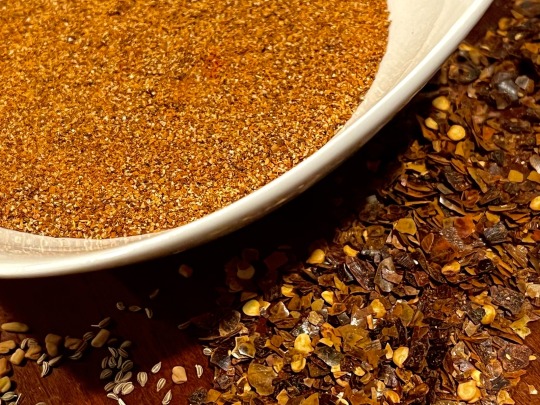
[ID: A close-up on the bottom right of a bowl filled with a red, brown, and yellow spice blend. The rest of the frame is taken up by scattered brown chili flakes, ajwain, and fenugreek seeds. End ID.]
Berbere / በርበረ (Ethiopian spice blend)
Berbere is a spice blend commonly used to flavor meat and vegetable dishes in the horn of Africa; mostly made up of Ethiopian brown chili peppers, it also commonly includes garlic and shallot, false cardamom, carom and nigella seeds, high-roasted fenugreek, cinnamon, and other spices and herbs. This recipe for an Ethiopian-style berbere produces a blend that imparts a smooth, even heat and a slight camphorous aroma to your final dish.
Premade berbere blends, even those from speciality spice stores, cut corners and cut costs—even if the spices are fresh and have always been stored sealed, the blend is unlikely to contain Ethiopian brown chilis, korerima, or besobela. This recipe provides a good baseline for a typical Ethiopian berbere if you're able to get your hands on these spices, rather than relying on undisclosed substitutions—but it does provide substitutions for anything you're unlikely to find in a local halaal grocery store in the U.S. or Europe. To avoid confusion with overlapping English translations (and because many recipes contain errors caused by them), Amharic terms, botanical (Latin) names, and false cognates to beware of are provided whenever necessary.
Recipe under the cut!
Patreon | Tip jar
Ingredients:
1/4 cup dried ground Ethiopian brown chili (berbere), or substitute New Mexico chilis
1 Tbsp sweet paprika (optional)
2 tsp garlic powder (nech shinkurt / ነጭ ሽንኩርት)
2 tsp dehydrated shallot or red onion (key shinkurt / ቀይ ሽንኩርት)
2 tsp false cardamom (korerima / ኮረሪማ; Aframomum melegueta)
1 tsp coriander seeds (dimbilal / ድንብላል)
1 tsp black mustard seeds (senafitch / ሰናፍጭ; Brassica nigra) (optional)
1/2 tsp fenugreek (abish or hulbet / አብሽ; Trigonella foenum-graecum), dark-roasted
1/2 tsp nutmeg (gewz; Myristica fragrans)
1/4 tsp ground ginger (zinjibel / ዝንጅብል; Zingiber officinale)
1/4 tsp carom seeds (nech azmud / ነጭ አዝሙድ; Trachyspermum ammi)
1/4 tsp nigella seeds (tikur azmud / ጥቁር አዝሙድ; Nigella sativa)
1/8 tsp true (Ceylon) cinnamon (k'elefa / ቀረፋ; Cinnamomum verum), or substitute cassia cinnamon
4 pieces Ethiopian long pepper (timiz; Piper capense); or Indian long pepper (Piper longum), also sometimes used under the name "timiz"
5 whole cloves (krenfud / ቅርንፉድ)
1 tsp Ethiopian holy basil (besobela / በሶቢላ)
1 tsp rue seeds (tena Adam / ጤናዳም; Ruta chalepenesis)
1 tsp Ethiopian rape seeds / Ethiopian mustard seeds (Brassica carinata), or substitute niger seeds (Guizotia abyssinica)
1 tsp koseret (ኮሰረት; Lippia abyssinica) (optional)
2 tsp salt
Berbere preparations vary from household to household, and spices may be added, removed, or rebalanced according to your preference. Less common inclusions are marked as optional; the spices and herbs that are the most vital are bolded.
See end notes for information on spices and substitions.
Instructions:
1. Heat a dry skillet over medium. Roast fenugreek, agitating occasionally, until it has considerably darkened to a medium brown. Set aside. Toast cinnamon, cloves, and korerima for a few minutes until fragrant and set aside.
2. Toast smaller whole spices (carom and nigella seeds) for a few minutes until fragrant and set aside.
3. Remove the pan from heat. Toast ground spices (ginger, paprika) for 30 seconds, stirring constantly, until fragrant.
4. Use a mortar and pestle or a spice grinder to grind all ingredients to a fine consistency. Pass through a fine mesh strainer and store in an airtight container in a cool, dark place.
Notes on spices and herbs
Ethiopian brown chili pepper / berbere

Known as "berbere" in Ethiopia, Ethiopian brown chilis have a rich, smoky, and tangy heat. Dried Ethiopian brown chilis or chili flakes may be purchased online, or you may substitute another type of chili (my choice would be New Mexico).
Paprika
Different varieties of paprika are all made of dried, toasted, and ground red bell peppers, but they vary in heat and in smokiness. For berbere you will need sweet paprika (not smoked paprika, hot paprika, or smoked hot paprika). The proportion of berbere to paprika can be varied a bit according to your preference to produce a milder or hotter blend, but beware of recipes calling for large amounts of paprika—berbere should be mostly chilis!
Dehydrated shallot
Shallots have a flavor similar to those of garlic and onion, but subtler and milder. Dehydrated shallot may be purchased at speciality spice stores, or online—or you can dehydrate thinly sliced shallots in a dehydrator or in an oven on low. Red onion powder is a possible substitute, as red onions are commonly used in place of shallots by people of Ethiopian descent in the United States.
Korerima / false cardamom

Korerima is also known as "grains of paradise," "black cardamom," or "false cardamom." Some recipes mistakenly call for Nepal cardamom in place of korerima, because Nepal cardamom is also known as "black cardamom" in English. The aroma of korerima once ground, though, is much more akin to that of green cardamom than to the smoky, camphorous aroma of Nepal cardamom.
Fenugreek / abish

Fenugreek seeds may be found in any halaal grocery store, where they may be called fenugreek or methi.
Carom seeds / nech azmud

Carom seeds may be found in any halaal grocery store, where they will be known as ajwain. You may also see these referred to as "white cumin" or "caraway seeds" in English, but don't confuse them with true caraway seeds (Carum carvi), which are larger.
Nigella seeds / tikur azmud
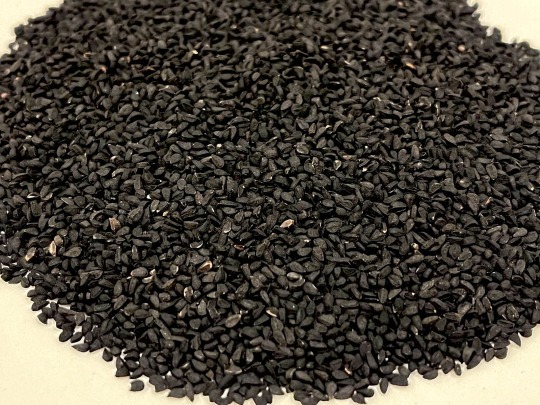
Because "tikur azmud" literally translates to "black cumin" in English, some recipes make the mistake of calling for kala jeera (Indian black cumin)—however, the seeds are from different plants entirely. "Tikur azmud" refers to the seeds of the Nigella sativa plant, which are known as nigella seeds in English cooking and kalonji in Indian cooking.
Ceylon cinnamon

Ceylon or true cinnamon is a variety of cinnamon commonly grown in Ceylon, Sri Lanka; it has a subtler, more nuanced and less bitter flavor than cassia cinnamon. Because it must be rolled by hand (unlike cassia cinnamon, which curls naturally), it tends to be more expensive than cassia. If you can't locate any Ceylon cinnamon, though, cassia is a good substitution.
Holy basil / besobela

Ethiopian holy basil is a subspecies of basil whose flowers have a distinctive fruity or tea-like aroma. Some recipes call for basil in place of besobela, but to my nose the aromas are nothing alike; I would favor camomile as a substitution, or omit the herb altogether.
Rue seeds / tena adam

"Tena Adam" (lit., "health of Adam) or "rue" is an aromatic plant the dried fruits of which are used in spice blends including berbere (the leaves are often used to flavor coffee). Ethiopian rue may be purchased online, or you may substitute for it a pinch of lemon or orange zest.
Long pepper / timiz
The berries of Piper capense, also known as African long pepper or Ethiopian long pepper. Piper capense grows across west Africa, south Africa, and the horn of Africa. Timiz is smoky, camphorous, and resinous, not as spicy or sharp as black or white pepper. Piper longum (Indian long pepper) berries, which are sharper in taste, are best known for their cultivation in Southeast Asia, but they are also grown and eaten in East Africa and may also be referred to as "timiz." In the U.S. and Europe, Ethiopian long pepper may be found online, or at a speciality African foods store, where it will be labelled "timiz"; Indian long pepper may be found at an Indian or halaal grocery store, where it will be labelled "pippali."
Salt
Traditional berbere blends typically contain salt. I tend to omit it, as it allows for more control over the salt content of a dish later on.
88 notes
·
View notes
Text

[ID: Whole spices including cloves, cinnamon, long pepper, and nutmeg in a small bowl. End ID.]
Mekelesha / መከለሻ (Ethiopian finishing spice blend)
Mekelesha wot is a finishing spice blend, added to dishes towards the end of cooking time so that the heat does not destroy their aromatics. Each cook adjusts their mekelesha blend to their own taste, but they usually include six or seven spices: Ethiopian false cardamom, long pepper, cumin, cloves, black pepper, and sometimes nutmeg.
Mekelesha adds complexity, intensity, and freshness to Ethiopian dishes, especially if made from whole spices at home. Also try it in other dishes such as kebabs, barbecue sauces, roasted vegetables, cooked salads, and more.
Recipe under the cut!
Patreon | Tip jar
Ingredients:
2 Tbsp Ethiopian false cardamom (korerima / ኮረሪማ; Aframomum melegueta), or substitute green cardamom
2 Tbsp (17g) Ethiopian long pepper (timiz / ጥምዝ; Piper capense)
1 1/2 Tbsp black pepper (kundo berbere)
1 Tbsp (7g) cumin seeds (kemun / ከሙን)
1 Tbsp (5g) whole cloves (krenfud / ቅርንፉድ)
4-inch chunk (5g) Ceylon cinnamon, or substitute cassia
1 nutmeg, crushed (optional)
See the notes at the end for a detailed description of spices and substitutions.
Instructions:
1. Toast whole spices one at a time in a small, dry skillet over medium heat. Toast each spice until it is fragrant, 30 seconds to 2 minutes; larger spices will take longer than smaller seeds. Set spices aside on a large plate and allow to cool.
2. Grind all spices in a coffee grinder or spice mill and filter through a fine mesh sieve. Store in an airtight container out of direct sunlight.
Notes on spices:
Korerima

Korerima is also known as “grains of paradise,” “black cardamom,” or “false cardamom.” Some recipes mistakenly call for Nepal cardamom in place of korerima, because Nepal cardamom is also known as ��black cardamom” in English. The aroma of korerima once ground, though, is much more akin to that of green cardamom than to the smoky, camphorous aroma of Nepal cardamom.
Ceylon cinnamon
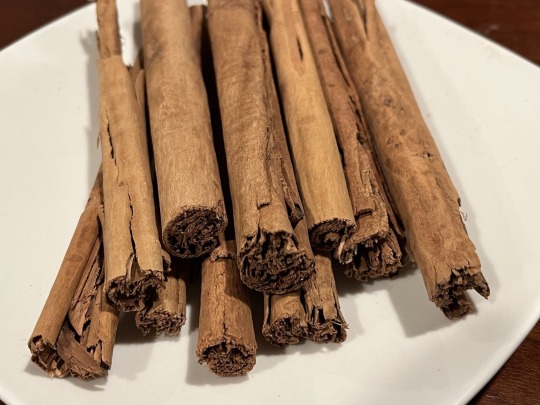
Ceylon or true cinnamon is a variety of cinnamon commonly grown in Ceylon, Sri Lanka; it has a subtler, more nuanced and less bitter flavor than cassia cinnamon. Because it must be rolled by hand (unlike cassia cinnamon, which curls naturally), it tends to be more expensive than cassia. If you can’t locate any Ceylon cinnamon, though, cassia is a good substitution.
Long pepper / timiz
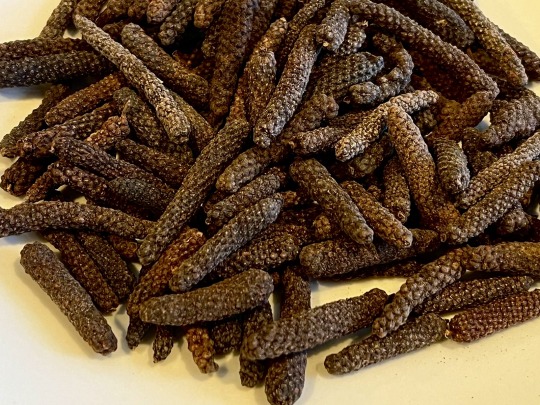
Long pepper is the dried berries of Piper capense, also known as African long pepper or Ethiopian long pepper. Piper capense grows across west Africa, south Africa, and the horn of Africa. It is smoky, camphorous, and resinous, not as spicy or sharp as black or white pepper. Piper longum (Indian or Bengal long pepper) berries, which are sharper in taste, are best known for their cultivation in Southeast Asia, but they are also grown and eaten in East Africa and may also be referred to as “timiz.” In the U.S. and Europe, Ethiopian long pepper may be found online, or at a speciality African foods store, where it will be labelled “timiz”; Indian long pepper may be found at an Indian or halaal grocery store, where it will be labelled "long pepper" or “pipli.”
If you can't find timiz, substitute 1 Tbsp black peppercorns and 1 Tbsp white peppercorns.
37 notes
·
View notes
Text
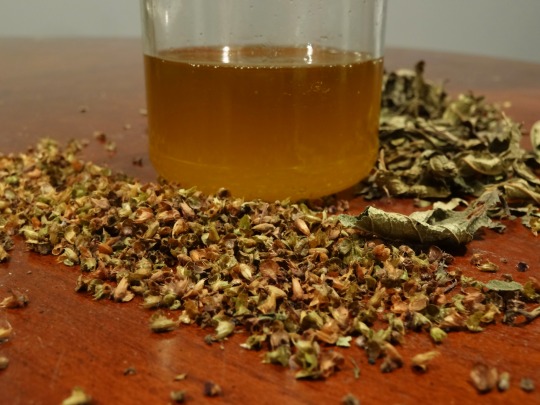
[ID: A jar half-full of a dark gold liquid. Dried herbs are scattered on the table around it. End ID.]
Niter kibbeh / ንጥር ቅቤ (Ethiopian clarified butter)
Niter kibbeh is a butter clarified with herbs and spices. It is commonly used in Ethiopia and Eritrea to add a fresh, robust, well-rounded flavor to meat dishes. Some less traditional recipes include it in Ethiopian lentil stews or use it as a cooking oil; you might also use it in place of ghee or a tadka to lend additional flavor to Indian dishes, or stir it into any soup, stew, or chili to add aroma.
This recipe is for a typical Ethiopian preparation that does not skip steps or rely on undisclosed substitutions of herbs and spices; however, substitutions are suggested for those without access to Ethiopian herbs.
Recipe under the cut!
Patreon | Tip jar
Makes about 1/2 cup.
Ingredients:
For the butter:
2 cups (460g) unsalted butter, ghee (Indian clarified butter), or smen (Moroccan clarified butter)
For a vegan version, use vegan ghee, vegan cultured butter, non-dairy margarine, or refined coconut oil.
Clarified butter and coconut oil contain less water than butter or margarine, so you may have a slightly higher yield with these bases (or reduce your starting amount to 1 3/4 cup). I tested this recipe with 2 cups of Earth Balance stick margarine.
For the manteria:
1 garlic clove
2 cm chunk ginger
1 cm chunk fresh turmeric root, or pinch of ground turmeric (optional)
A few slices shallot or red onion
2 Tbsp (1.5g) dried koseret (ኮሰረት)
2 Tbsp (2.3g) dried Ethiopian holy basil (besobela / በሶቢላ), or one sprig fresh besobela
1 Tbsp Ethiopian false cardamom (korerima / ኮረሪማ)
2 tsp fenugreek seeds (abish or hulbet / አብሽ)
2 tsp nigella seeds (tikur azmud / ጥቁር አዝሙድ)
2 tsp carom seeds (netch azmud / ነጭ አዝሙድ)
Pinch of salt
The "kibbeh manteria" / ቂቤ ማንጠሪያ (or "ye kibe kimem") is the blend of herbs and spices added to the butter while it’s clarifying—the verb "manter" means "to clarify." Each cook has their own preferred manteria recipe, but they are commonly made of some combination of shallot, ginger, garlic, korerima, nigella seeds, carom seeds, fenugreek, besobela, koseret, rosemary, and turmeric.
See notes on spices and herbs at the end.
Instructions:
Niter kibbeh is usually made using clarified fermented butter. If you're starting from a base of ghee or smen (clarified fermented butters which may be readily purchased at halaal grocery stories in the U.S.A. and Europe) or vegan fermented butter, all you need to do is heat the butter with the manteria and then strain. If you're starting from a base of fresh butter, you might choose to ferment it yourself for about a month, or skip this step. I have not tested the fermentation step with non-dairy margarine.
1. Dark-roast the fenugreek. Heat a dry skillet over medium. Roast fenugreek, agitating occasionally, until it has considerably darkened to a medium brown. Set aside and allow to cool. Gring using a mortar and pestle or spice mill.
2. Ferment the butter. If using fresh butter, allow it to soften at room temperature and mix it with a teaspoon of fenugreek and about a tablespoon of koseret until well-combined. Allow to mature in a sealed container at room temperature for 30-40 days, until it is very soft and smooth and smells pungent and well-fermented. This will take longer in a cold climate than a hot one.
Make sure that your storage container and anything else that will touch the butter are clean and dry, and that the container is airtight. If the butter develops mold, discard it.
3. Prepare the wet mixture. Peel and crush garlic, ginger, shallot or onion, and fresh turmeric into a paste using a mortar and pestle. If your besobela is fresh rather than dried, crush it along with the aromatics at this point.
4. Prepare the dry mixture. Coarsely crush dried herbs and spices in a mortar and pestle or spice mill.
5. Make the niter kibbeh. Heat butter, margarine, or coconut oil on medium until melted. Add dry spices and herbs and cook, stirring often, until simmering. You will know when dairy butter is ready for you to proceed to the next step because its foam will dissipate.
6. Add wet herbs and aromatics and lower heat to low. Cook, stirring often, for about 10 minutes or until fragrant. Take off the heat and allow to cool.
7. Strain through a cheesecloth and store in an airtight container, refrigerated, for up to several months. The niter kibbeh will solidify in the fridge.
Notes on spices and herbs:
Besobela
Ethiopian holy basil is a subspecies of basil whose flowers have a distinctive fruity or tea-like aroma. Dried besobela may be purchased online.
Some recipes call for basil or oregano in place of besobela, but to my nose the aroma of besobela is more akin to that of camomile; you might use a mixture of basil and camomile.
Korerima
Korerima, also known as “grains of paradise,” “black cardamom,” or “false cardamom,” is the seed of a plant in the ginger family. Some recipes mistakenly call for Nepal cardamom in place of korerima, because Nepal cardamom is also known as “black cardamom” in English. The aroma of korerima once ground, though, is much more akin to that of green cardamom than to the smoky, camphorous aroma of Nepal cardamom; I would suggest green cardamom as a substitution.
Some niter kibbeh recipes use both the seed and seed pods of 'unhulled' korerima.
Netch azmud
Carom seeds may be found in any halaal grocery store, where they will be labelled "ajwain." You may also see these referred to as “white cumin” or “caraway seeds” in English, but don’t confuse them with true caraway seeds (Carum carvi), which are larger.
Tikur azmud
Because “tikur azmud” literally translates to “black cumin” in English, some recipes make the mistake of calling for kala jeera (Indian black cumin)—however, the seeds are from different plants entirely. “Tikur azmud” refers to the seeds of the Nigella sativa plant, which are known as nigella seeds in English cooking and kalonji in Indian cooking.
Koseret
Koseret, Lippia abyssinica, is a species of plant in the verbena family with a mint-like, camphorous aroma. Dried koseret may be found at a specialty spice store, or online.
Koseret has antibacterial properties which aid in preserving butter; I have not tested fermenting butter without it. You might try a mixture of dried mint and basil as a substitution, but check on the butter frequently if you are fermenting it.
48 notes
·
View notes